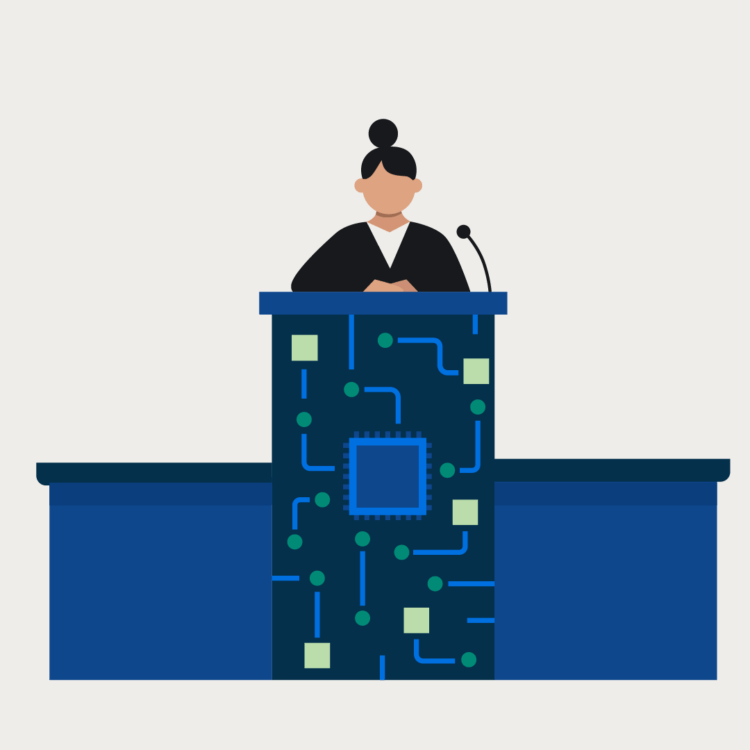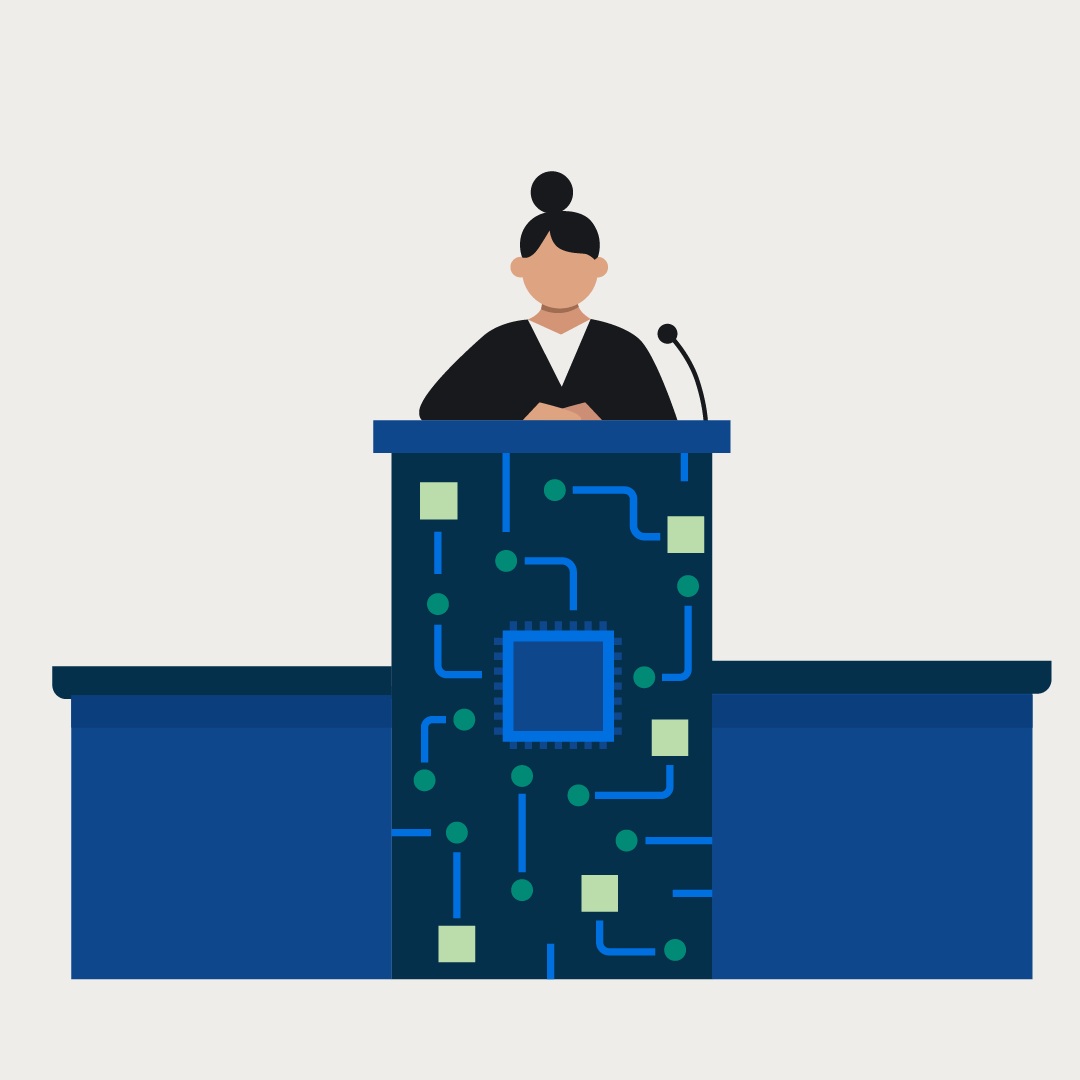From streamlining processes to automating workflows to enhancing accessibility, artificial intelligence (AI) holds enormous potential to augment the efficiency and effectiveness of our legal system including the courts.
But how does this transformation manifest in the courtroom? How are courts leveraging these advanced tools to redefine justice delivery?
In this article, we delve into three key areas where AI is poised to make a significant impact in courts:
- Transcription
- Translation
- Judicial guidance
We’ll dissect how these technologies are being applied, their potential benefits, and the challenges we must address to ensure their successful and responsible implementation.
Ready to take your firm’s efforts to the next level? Clio Duo can help! Discover our dynamic AI-powered partner, transforming the way legal professionals work–Learn more here.
What does AI look like in the courtroom?
When we talk about AI, we refer to machine systems capable of performing tasks that normally require human interpretation and effort. This includes understanding natural language, recognizing patterns, solving problems, and making decisions. These tools enhance productivity by collecting, transforming, and publishing information in new quick ways.
In the realm of law, large language model tools like ChatGPT are being considered for a variety of tasks, including drafting legal documents, conducting legal research, and even predicting case outcomes.
These AI tools have the potential to transform the way all types of court professionals work, bringing efficiency and precision into traditionally time-consuming processes.
Let’s explore the three areas that AI can be used in courtrooms.
1. AI can help with transcription in courts
The role of stenographers in courtrooms is crucial. They create an official record of all spoken words during hearings and trials, preserving important court records for posterity.
Yet, with advancements in AI, we’re seeing the potential for tools to step into this role.
AI transcription services can listen to spoken words and translate them into text in real time, creating robust court transcripts. AI transcription can also be applied to recorded depositions and other types of audio and video evidence, making it easier to create a robust set of searchable records no matter the format of the original material.
The advantages are clear: AI transcription services can generate instantaneous records around court activities and hearings, speeding up processes and reducing the cost of judicial services. It can enhance the accessibility of records, making them available for review almost immediately after a proceeding.
However, concerns remain.
The human aspect of stenography isn’t just about transcribing words; it’s about understanding context and nuance. And while AI has made leaps and bounds in this area, questions about accuracy persist: How do we verify or disprove any claims of inaccuracy?
These are challenges that we need to address as we continue to integrate AI into the courtroom.
2. AI can help with translation in courts
Language barriers can pose significant obstacles in court proceedings. Many individuals are denied access to court services because they cannot understand or communicate effectively in a court’s default language.
California state courts have some of the greatest need and resources for language interpreters. In their 2020 Language Need and Interpreter Use Study: Report to the Legislature, California courts reported the following:
- There were over one million interpretations a year for each of the four previous fiscal years.
- Criminal cases are the main driver of interpretation volume representing around 75% of the total recorded volume.
- Criminal case interpretations numbered approximately 3.3 million for the study’s four-year period.
This means that the use of interpreters in civil proceedings is small, implying that the state’s highly diverse population may not be accessing courts for civil justice services as much as English-speaking populations.
Even with years of research and good intentions, California’s Court Interpreters Advisory Panel (CIAP) reports difficulties in securing adequate translation resources. Steadily rising costs and the expansion of interpreter services into civil matters has led to regular shortfalls in the court interpreter budgets.
Here’s where AI can play a transformative role.
Generative AI can take written formats and convert them to audio, aiding those who are illiterate or for whom English is not a first language.
Additionally, AI translation services can provide on-the-fly translation for witnesses, plaintiffs, and defendants who are non-English speakers. This not only opens up the possibility for more inclusive proceedings and ensures that justice is not hampered by language barriers.
Yet, as with transcription, accuracy is a concern. For example:
- Can these AI models interpret appropriately and translate both literal and idiomatic expressions?
- Are they able to convey emotionally charged words used in testimonies?
- Furthermore, how does AI translation impact the perceived credibility of a witness?
- Will judges or juries view testimony provided through AI translation differently?
There are also considerations about vocal characteristics and their potential impact on perception. Research, such as a report by UNESCO on gendered AI, shows that gendered voice assistants receive disparate treatment, raising questions about how this could translate in a courtroom setting.
If an AI-translation presents differently than the person testifying, like a female voice with a male witness, or the AI defaults to an accent that has culturally-coded meaning with a jury, is a potential miscarriage of justice happening?
3. AI can help guide judges
AI is also finding its way into the judge’s chambers. Already, judges in India and Colombia are using ChatGPT to help justify their reasoning and answer legal questions, respectively. Tools like CARA by Casetext help judges evaluate briefs, conduct legal research, and aid in drafting rulings. They can sift through mountains of legal data and pinpoint relevant information, making the decision-making process more efficient.
However, the use of AI extends beyond mere assistance. Machine learning tools are being used to provide recommendations for bail and parole determinations.
While these tools can speed up the decision-making process, they are not without flaws. Studies, such as the one conducted by ProPublica, show that these tools can contain systemic bias in their data, leading to skewed results.
Transparency is another issue, as companies often don’t disclose their algorithms, citing trade secrecy.
These issues raise questions about the potential for undue influence on the judiciary and the preservation of its independence. Judges and lawyers need to advocate for full transparency on the AI tools used when issuing rulings or decisions and protect a court’s discretionary authority to fight the machine recommendations.
Final thoughts on AI in the courtroom
AI holds immense potential to revolutionize the legal landscape, from transcription and translation services to aiding judges in their duties. It can improve the efficiency and effectiveness of the legal system, making justice more accessible to all. However, we must approach this new frontier responsibly, addressing the challenges that come with it.
Clio’s generative AI solution, Clio Duo, is here! Seamlessly embedded within Clio, Clio Duo empowers lawyers to use the power of AI to help with routine tasks and offer insights into how to run their practices more efficiently—book a demo to see Clio Duo in action at your firm.
Frequently Asked Questions
How is artificial intelligence used in court?
Legal AI Virtual Summit 2025
Watch Clio’s Legal AI Virtual Summit to explore practical AI strategies for law firms of all sizes. Learn how to use AI securely, protect client data, and enhance your practice.
Watch now


